Development and Numerical Simulation of a Precision Strip-Hole Layered Fertilization Subsoiler While Sowing Maize
Abstract
:1. Introduction
2. Materials and Methods
2.1. Agronomic Requirements
2.2. Theory and Calculation of Model
2.2.1. Design of Layered Fertilizer No-Tillage Planter
2.2.2. Precision Strip-Hole Layered Fertilizer Subsoiler
2.2.3. Design and Parametric Analysis of Key Components
2.2.4. Mechanical Analysis of the Fertilization Process
2.2.5. Mechanical Analysis of the Fertilizer Unloading Process
2.3. Simulation Model Building
2.4. Experimental Design and Evaluation Methods
3. Results
3.1. Effect of Factors on the Effectiveness of Fertilizer Application
3.1.1. The Effect of the AFT on the Fertilization Effect
3.1.2. Effect of Factors on Cavity Formation Performance
3.2. Field Test
4. Discussion
5. Conclusions
- (1)
- The precision strip-hole layered fertilizer subsoiler was designed, which can apply fertilizer to the soil in quantitative and fixed positions according to the fertilizer requirements of the maize growth cycle and the length of the root system in each period, facilitating the absorption of fertilizer nutrients by the maize; the subsoiler can deeply loosen the lower layer of soil, helping to reduce soil erosion, increase the water storage capacity of the soil, improve the growth environment of the maize root system and facilitate the growth and development of the maize root system and the full absorption of fertilizer nutrients.
- (2)
- In the determination of the size of the type of hole wheel by theoretical analysis and para-metric calculation of the type hole wheel, the main factors influencing the effectiveness of the application of fertilizer in the strip-hole stratification unit are the AUF, the AFT and the forward speed. At a forward speed of 2 km/h, AUF at 60° and AFT at 35°, the simulation yielded a minimum FADSC of 2.49% and 2.93% for the middle and lower layers of FADSC, respectively. The field trials yielded were 11.36% and 12.43% for the middle and lower layers of FADSC, which met the fertilizer application criteria of the cavity applicator.
- (3)
- In summary, the idea of the stratified strip-hole application was essential to meet the demand for fertilizer at all times of maize growth, while using strip hole fertilization in the middle and lower layers can reduce fertilizer consumption and improve fertilizer utilization efficiency, which has a positive effect on environmental protection. The idea also can provide a new concept for precision fertilization machines.
Author Contributions
Funding
Institutional Review Board Statement
Informed Consent Statement
Data Availability Statement
Conflicts of Interest
References
- Wang, W.W.; Wu, K.P.; Zhang, Y.; Wang, M.X.; Zhang, C.L.; Chen, L.Q. The Development of an Electric-Driven Control System for a High-Speed Precision Planter Based on the Double Closed-Loop Fuzzy PID Algorithm. Agronomy 2022, 12, 945. [Google Scholar] [CrossRef]
- Wang, L.Y. Study on the comparative advantages of major food crops in China. Rural Econ. Technol. 2020, 31, 19–20. [Google Scholar]
- Wan, L.; Xie, D.B.; Li, Y.; Chen, L.Q. Design and experiments of a roller type hole application and fertilizer row dispenser for maize. J. Agric. Mach. 2020, 51, 64–73. [Google Scholar]
- Rotundo, J.L.; Rech, R.; Cardoso, M.M.; Fang, Y.; Tang, T.; Olson, N.; Pyrik, B.; Conrad, G.; Borras, L.; Mihura, E.; et al. Development of a decision-making application for optimum soybean and maize fertilization strategies in Mato Grosso. Comput. Electron. Agric. 2022, 193, 106659. [Google Scholar] [CrossRef]
- Basso, B.; Sartori, L.; Cammarano, D.; Fiorentino, C.; Grace, P.R.; Fountas, S.; Sorensen, C.A. Environmental and economic evaluation of N fertilizer rates in a maize crop in Italy: A spatial and temporal analysis using crop models. Biosyst. Eng. 2012, 113, 103–111. [Google Scholar] [CrossRef]
- Zhou, B.Y.; Sun, X.F.; Ding, Z.S.; Ma, W.; Zhao, M. Effects of soil tillage and fertilizer application on dry matter accumulation and yield of summer maize. Chin. Agric. Sci. 2017, 50, 2129–2140. [Google Scholar]
- Yang, Q.L.; Huang, X.Y.; Wang, Q.J.; Li, H.W.; Wang, Y.B.; Wang, L.Y. Structural optimization and experimentation of a spatially layered fertilizer application unit for maize. J. Agric. Mach. 2020, 51, 175–185. [Google Scholar]
- Yu, C.Y.; Liu, J.; Yin, J.N.; Bi, L.L.; Zhang, S.; Zhou, H.Y.; Zhu, D.Q. Design and optimization and experimental verification of a segmented double-helix blade roller for straw returning cultivators. J. Chin. Inst. Eng. 2021, 44, 379–387. [Google Scholar] [CrossRef]
- Chen, Z.Y.; Duan, W.W.; Wang, G.Y.; Li, B.; Chen, Z.P. Effects of slow-release fertilizer application methods on population growth and yield of summer maize. Jiangsu Agric. Sci. 2021, 49, 92–96. [Google Scholar]
- Wyngaard, N.; Echeverría, H.E.; Rozas, H.R.; Divito, G.A. Fertilization and tillage effects on soil properties and maize yield in a Southern Pampas Argiudoll. Soil Tillage Res. 2012, 119, 22–30. [Google Scholar] [CrossRef]
- Huang, X.; Wang, W.W.; Li, Z.D.; Wang, Q.Q.; Zhu, C.X.; Chen, L.Q. Design method and experiment of machinery for combination of seed fertilizer and herbicide. Int. J. Agric. Biol. Eng. 2019, 12, 63–71. [Google Scholar]
- Lou, S.Y.; He, J.; Li, H.W.; Wang, Q.J.; Lu, C.Y.; Liu, W.Z.; Liu, P.; Zhang, Z.G.; Li, H. Current Knowledge and Future Directions for Improving Subsoiling Quality and Reducing Energy Consumption in Conservation Fields. Agriculture 2021, 11, 575. [Google Scholar] [CrossRef]
- Hamza, M.A.; Anderson, W.K. Soil compaction in cropping systems: A review of the nature, causes and possible solutions. Soil Tillage Res. 2005, 82, 121–145. [Google Scholar] [CrossRef]
- Zhao, Y.Z.; Wang, Y.; Gong, Z.P.; Yang, Y.Q.; Zhao, S.H.; Gou, J.B. Design and test of no-till planter side deep layered fertilizer application seeding components. J. Agric. Mach. 2021, 52, 40–50. [Google Scholar]
- Zhai, L.; Xu, P.; Zhang, Z.; Li, S.; Xie, R.; Zhai, L.; Wei, B. Effects of deep vertical rotary tillage on dry matter accumulation and grain yield of summer maize in the Huang-Huai-Hai Plain of China. Soil Tillage Res. 2017, 170, 167–174. [Google Scholar] [CrossRef]
- da Silva, R.F.; da Costa Severiano, E.; de Oliveira, G.C.; Barbosa, S.M.; Peixoto, D.S.; Tassinari, D.; Silva, B.M.; Silva, S.H.G.; Júnior, M.D.S.D.; Figueiredo, T.D.A.F.R. Changes in soil profile hydraulic properties and porosity as affected by deep tillage soil preparation and Brachiaria grass intercropping in a recent coffee plantation on a naturally dense Inceptisol. Soil Tillage Res. 2021, 213, 105127. [Google Scholar] [CrossRef]
- Scanlan, C.A.; Davies, S.L. Soil mixing and redistribution by strategic deep tillage in a sandy soil. Soil Tillage Res. 2019, 185, 139–145. [Google Scholar] [CrossRef]
- Schneider, F.; Don, A.; Hennings, I.; Schmittmann, O.; Seidel, S.J. The effect of deep tillage on crop yield—What do we really know? Soil Tillage Res. 2017, 174, 193–204. [Google Scholar] [CrossRef]
- Quan, L.Z.; Feng, H.Q.; Lv, Y.J.; Wang, Q.; Yuan, Z.Y. Maize seedling detection under different growth stages and complex field environments based on an improved Faster R–CNN. Biosyst. Eng. 2019, 184, 1–23. [Google Scholar] [CrossRef]
- Wang, Y.X.; Liang, Z.J.; Cui, T.; Zhang, D.X.; Qu, Z.; Yang, L. Structural design and experiment of maize layered fertilizer applicator. J. Agric. Mach. 2016, 47, 163–169. [Google Scholar]
- Yang, R.B.; Yang, H.G.; Lian, Z.G.; Zhang, X.; Guo, D.; Zheng, Y.Y. Design and experiment of a layered fertilizer opener for potato planters. J. Agric. Mach. 2018, 49, 104–113. [Google Scholar]
- Yang, X.L.; Zhao, H.; Yang, R.B.; Wu, X.F.; Wang, Z.Z. Design and hydrostatic simulation of a layered fertilizer opener for potato planters. Agric. Eng. 2019, 9, 81–84. [Google Scholar]
- Qian, F.F. Design and Experiment of Maize Hole Fertilizer Applicator; Anhui Agricultural University: Hefei, China, 2016. [Google Scholar]
- Wu, R.R.; Zhang, L.Y.; Qian, F.F.; Cai, H.T. Design and simulation of maize hole fertilizer application device. J. Anhui Agric. Univ. 2017, 44, 941–946. [Google Scholar]
- Zhang, J.X.; Liu, H.M.; Gao, J.; Lin, Z.H.; Chen, Y. Simulation and experiments of SPH of a layered orthotropic hole fertilizer precision sowing machine for maize. J. Agric. Mach. 2018, 49, 66–72. [Google Scholar]
- Liu, Z.D.; Wang, Q.J.; Liu, C.G.; Li, H.W.; He, J.; Liu, J.X. Design and experiments of a cavity-disk type precision cavity fertilizer application device. J. Agric. Mach. 2018, 49, 137–144. [Google Scholar]
- Wang, Q.Q.; Li, Z.D.; Wang, W.W.; Zhang, C.L.; Chen, L.Q.; Wan, L. Multi-objective optimization design of wheat centralized seed feeding device based on particle swarm optimization (PSO) algorithm. Int. J. Agric. Biol. Eng. 2020, 13, 76–84. [Google Scholar] [CrossRef]
- Yang, Q.L.; Wang, Q.J.; Li, H.W.; He, J.; Lu, C.Y.; Yu, C.C.; Lou, S.Y.; Wang, Y.B. Development of a layered fertilizer application adjustment device for pneumatic collector-discharge variable fertilizer system. J. Agric. Eng. 2020, 36, 1–10. [Google Scholar]
- Wang, X.; Zhang, S.; Pan, H.; Zheng, Z.; Huang, Y.; Zhu, R. Effect of soil particle size on soil-subsoiler interactions using the discrete element method simulations. Biosyst. Eng. 2019, 182, 138–150. [Google Scholar] [CrossRef]
- Wang, W.W.; Bai, Z.W.; Li, Z.Q.; Xie, D.B.; Chen, L.Q.; Wang, H. Straw/Spring Teeth Interaction Analysis of Baler Picker in Smart Agriculture via an ADAMS-DEM Coupled Simulation Method. Machines 2021, 9, 296. [Google Scholar] [CrossRef]
- Fang, L.F.; Cao, C.M.; Li, Q.; Qi, K.; Sun, X.D.; Ge, J. Fracture Analysis of Compacted Clay Soil Beams with Offset Notches Based on Three-Point Bending Test: Experimental Characterization and Numerical Simulation. Adv. Civ. Eng. 2022, 2022, 3699196. [Google Scholar] [CrossRef]
- Du, X.; Liu, C.L.; Jiang, M.; Yuan, H.; Dai, L.; Li, F.L. Design and experiment of tilted trapezoidal hole type cavity fertilizer discharger. J. Agric. Mach. 2021, 52, 43–53. [Google Scholar]
- Gaj, R.; Szulc, P.; Siatkowski, I.; Waligóra, H. Assessment of the effect of the mineral fertilization system on the nutritional status of maize plants and grain yield prediction. Agriculture 2020, 10, 404. [Google Scholar] [CrossRef]
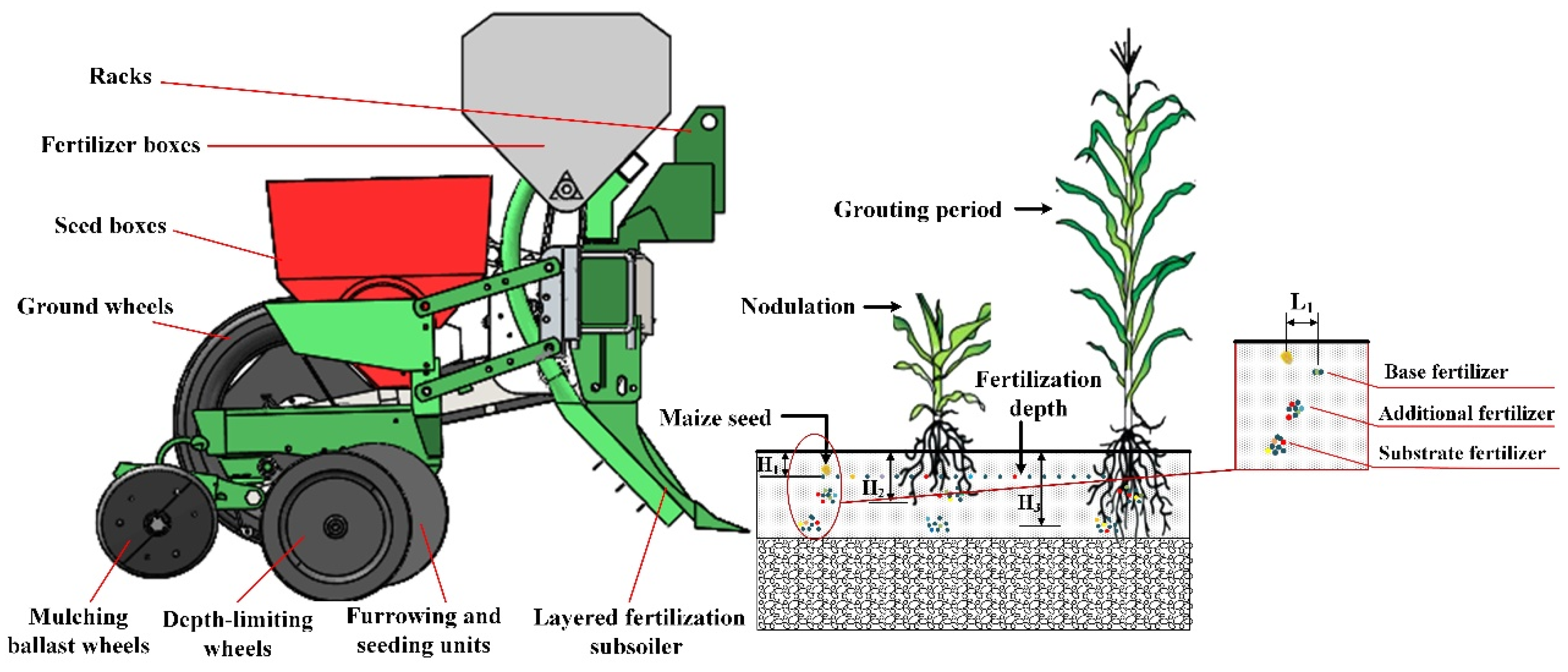
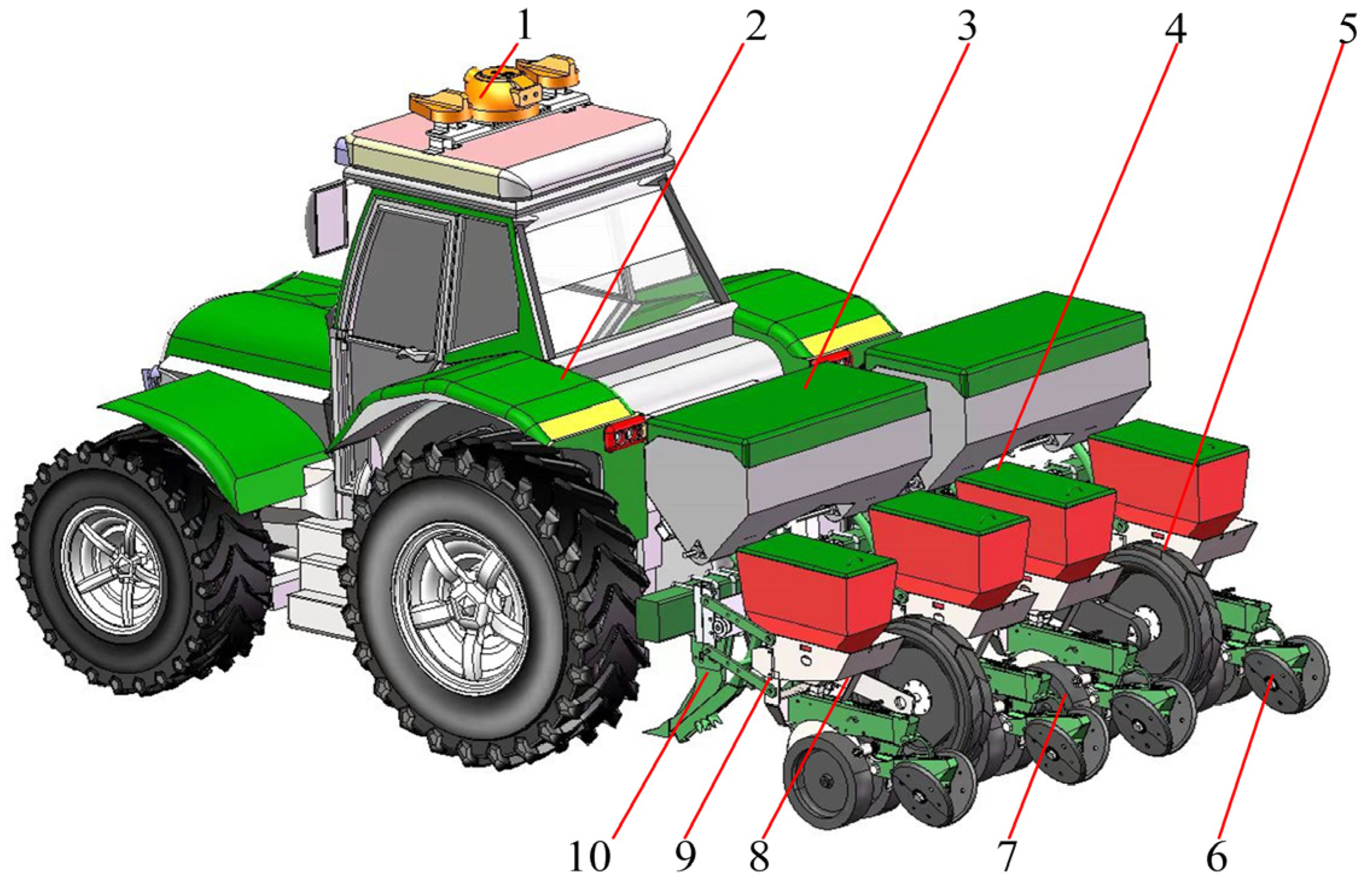


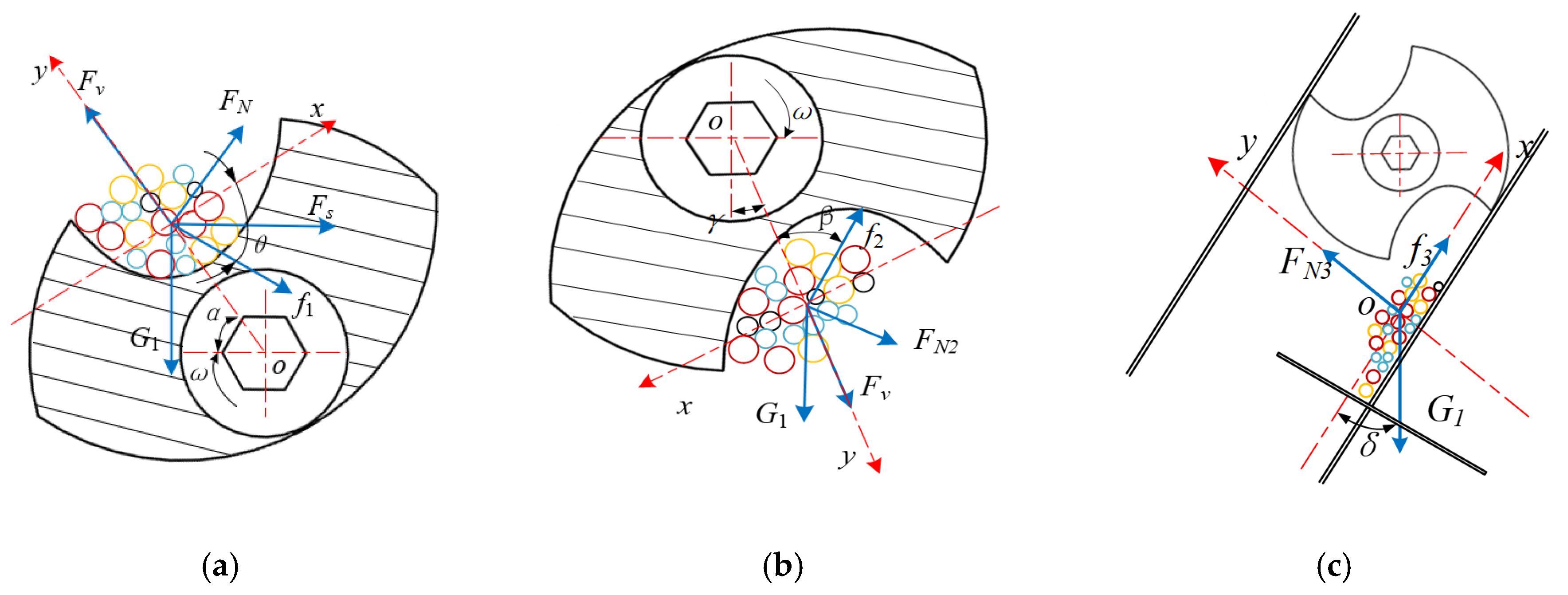
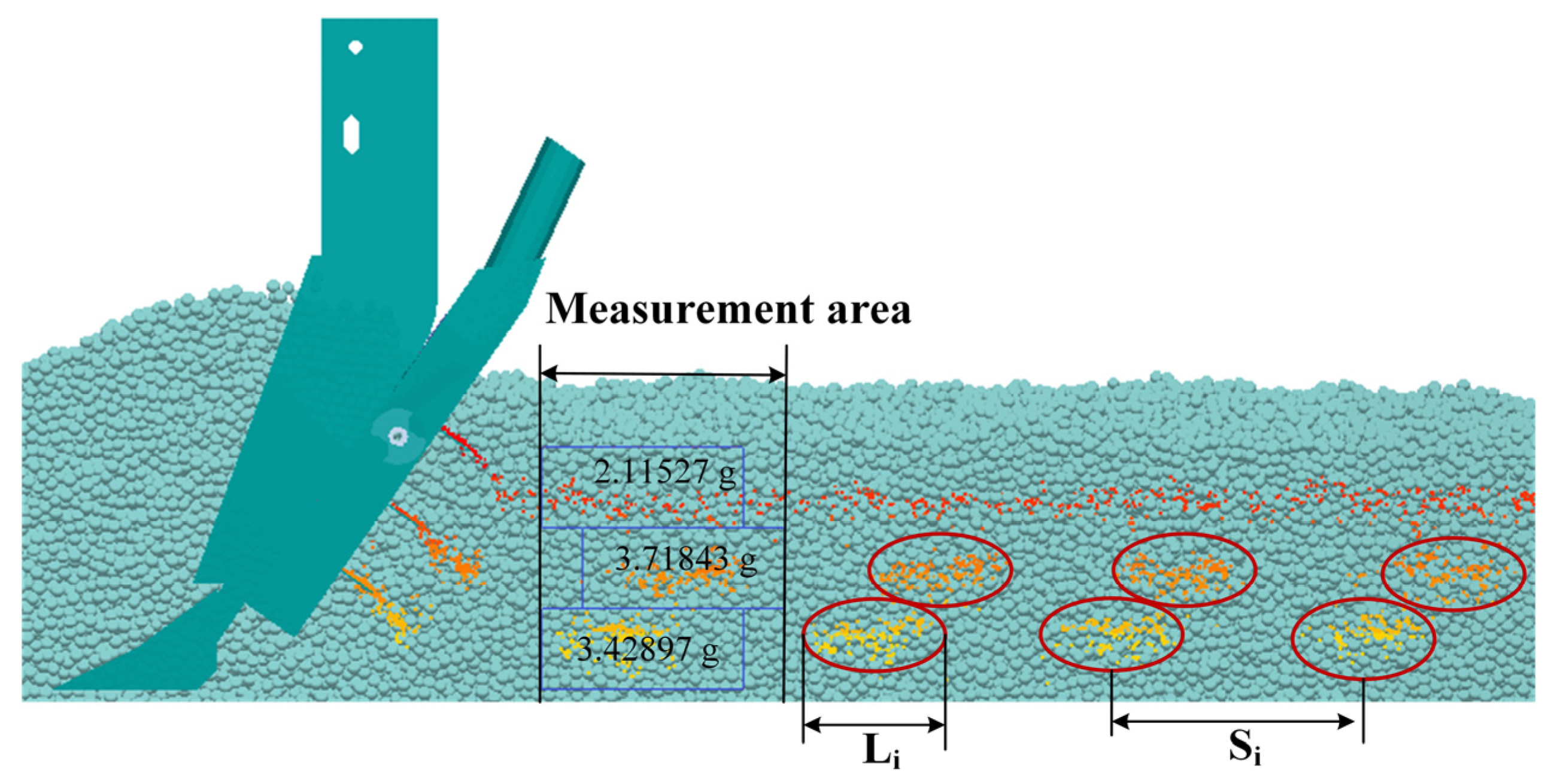
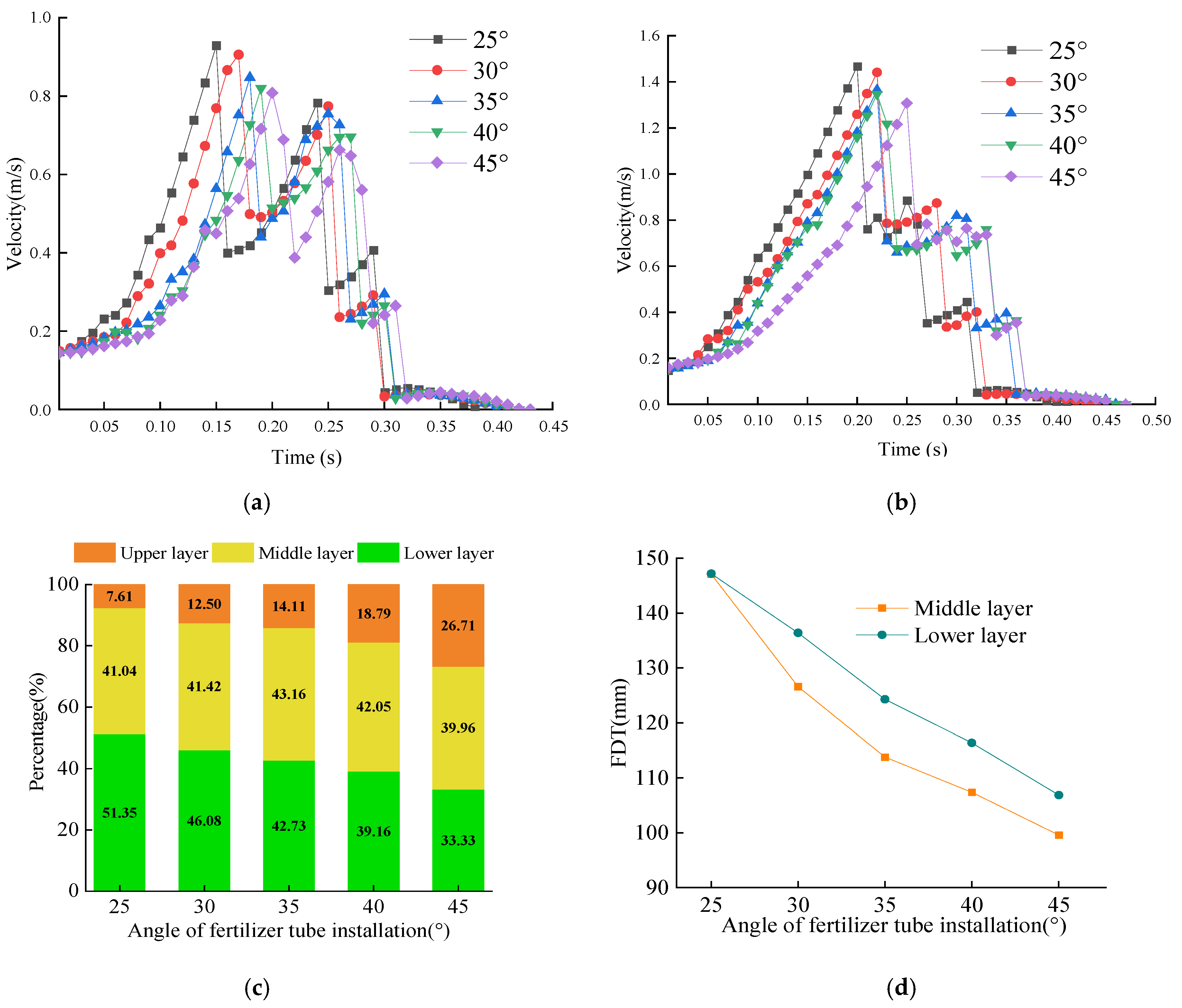

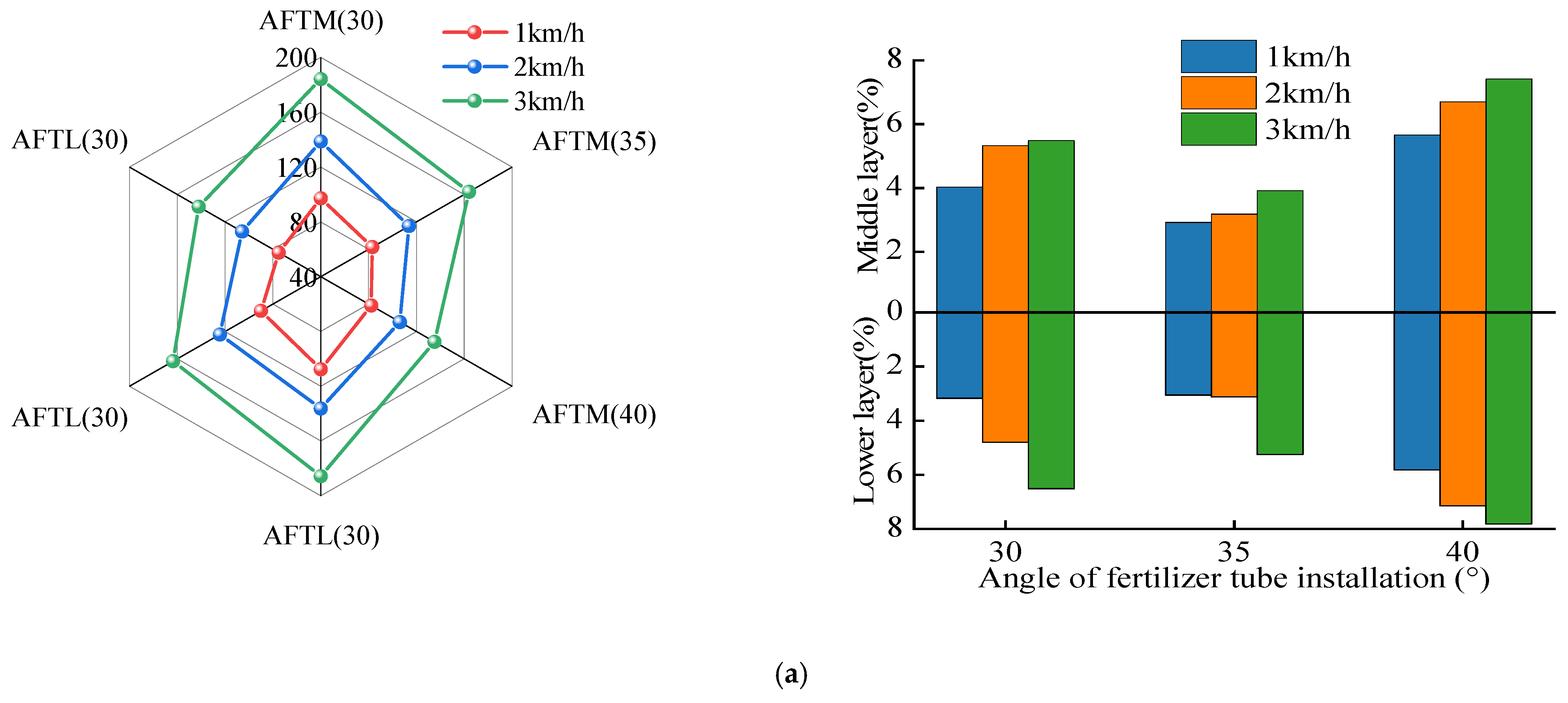
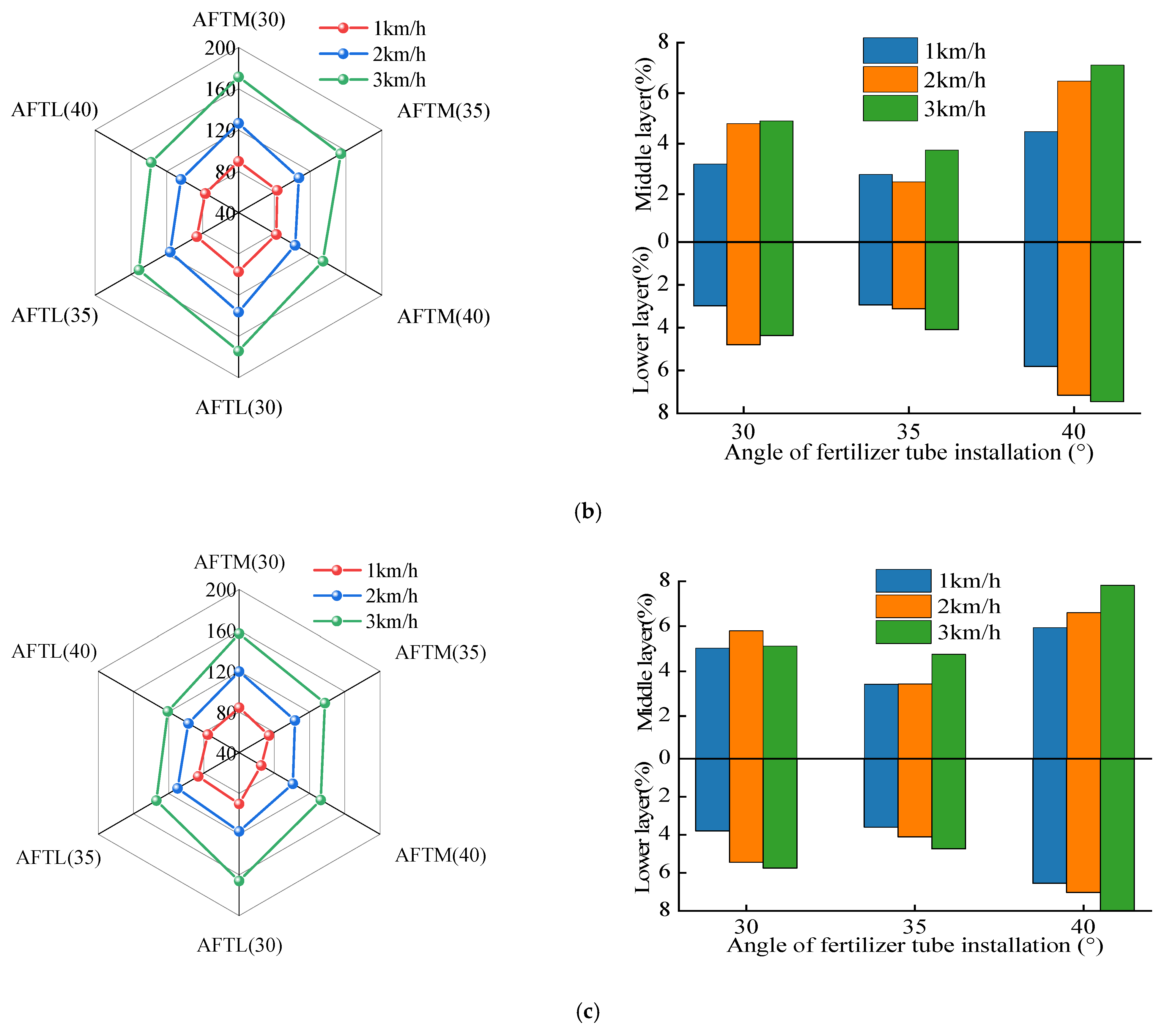
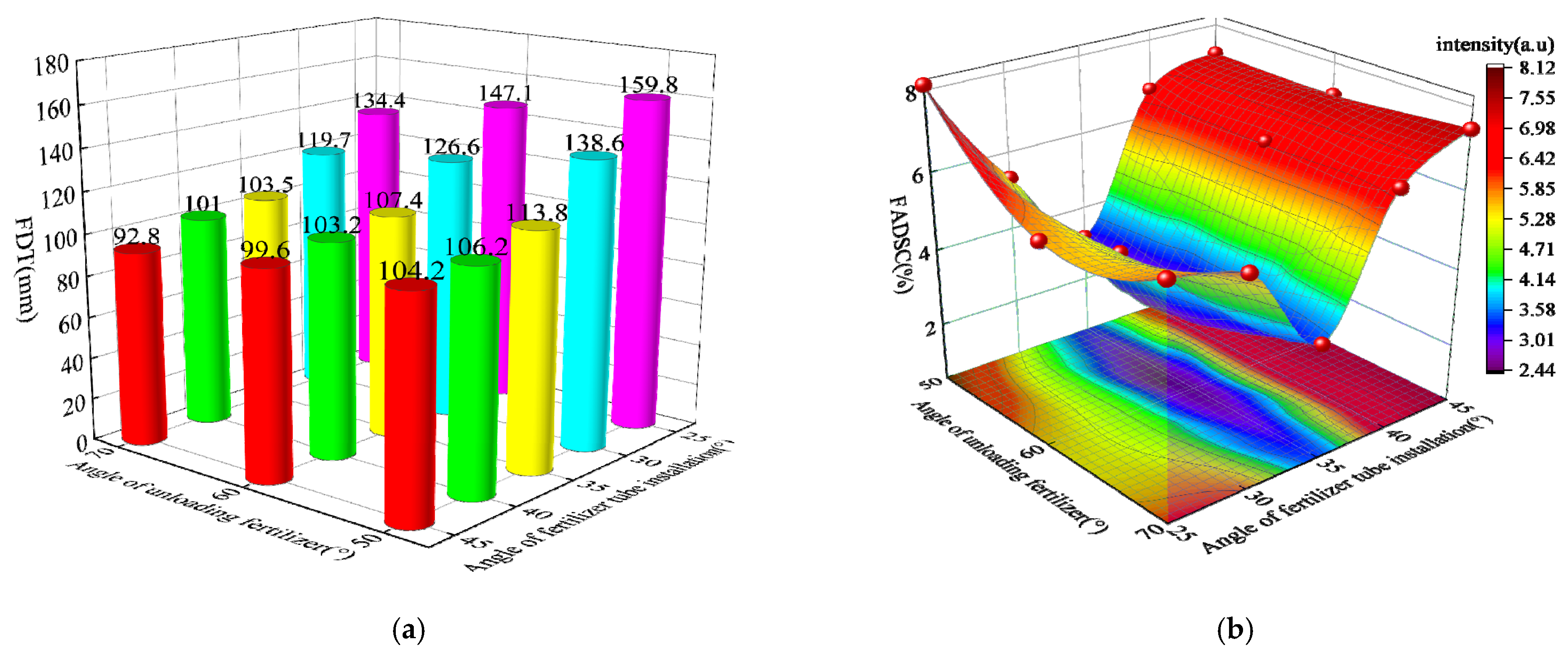
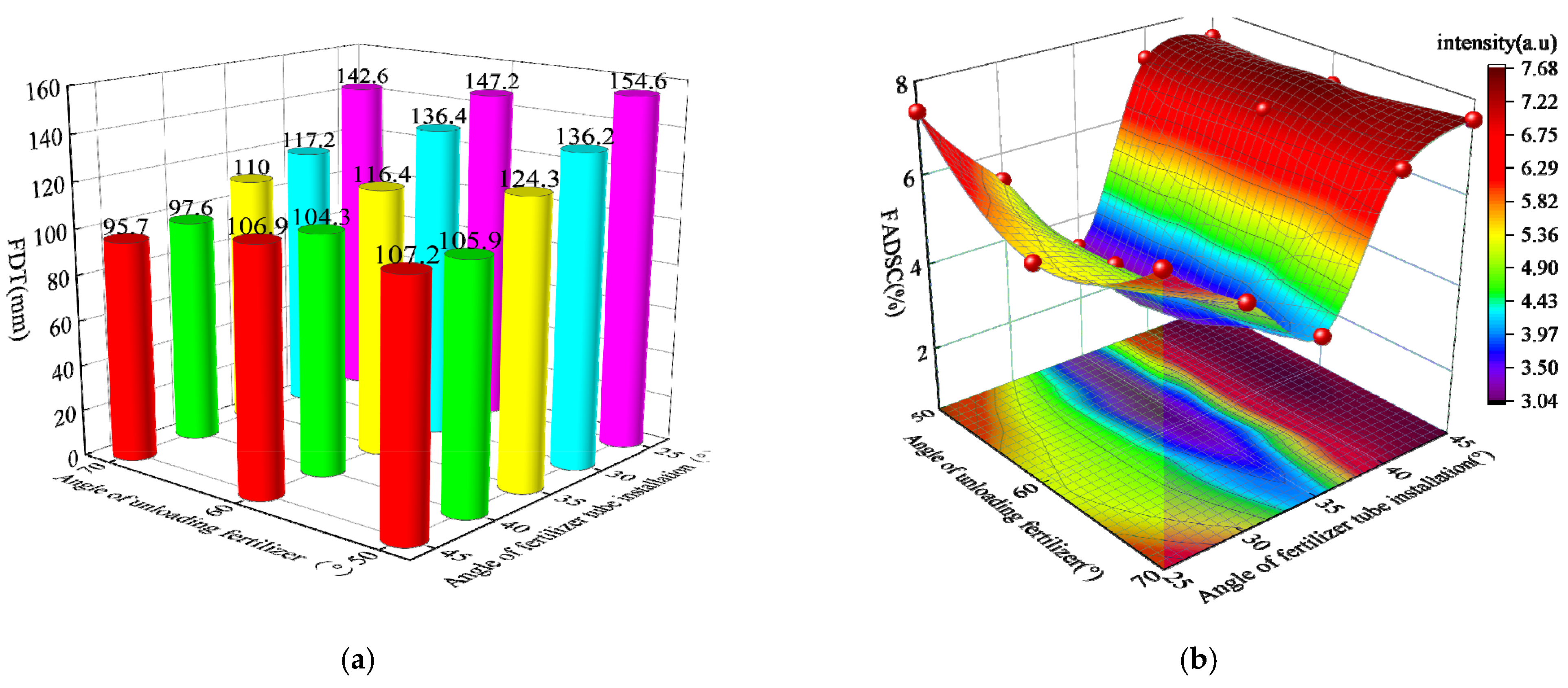
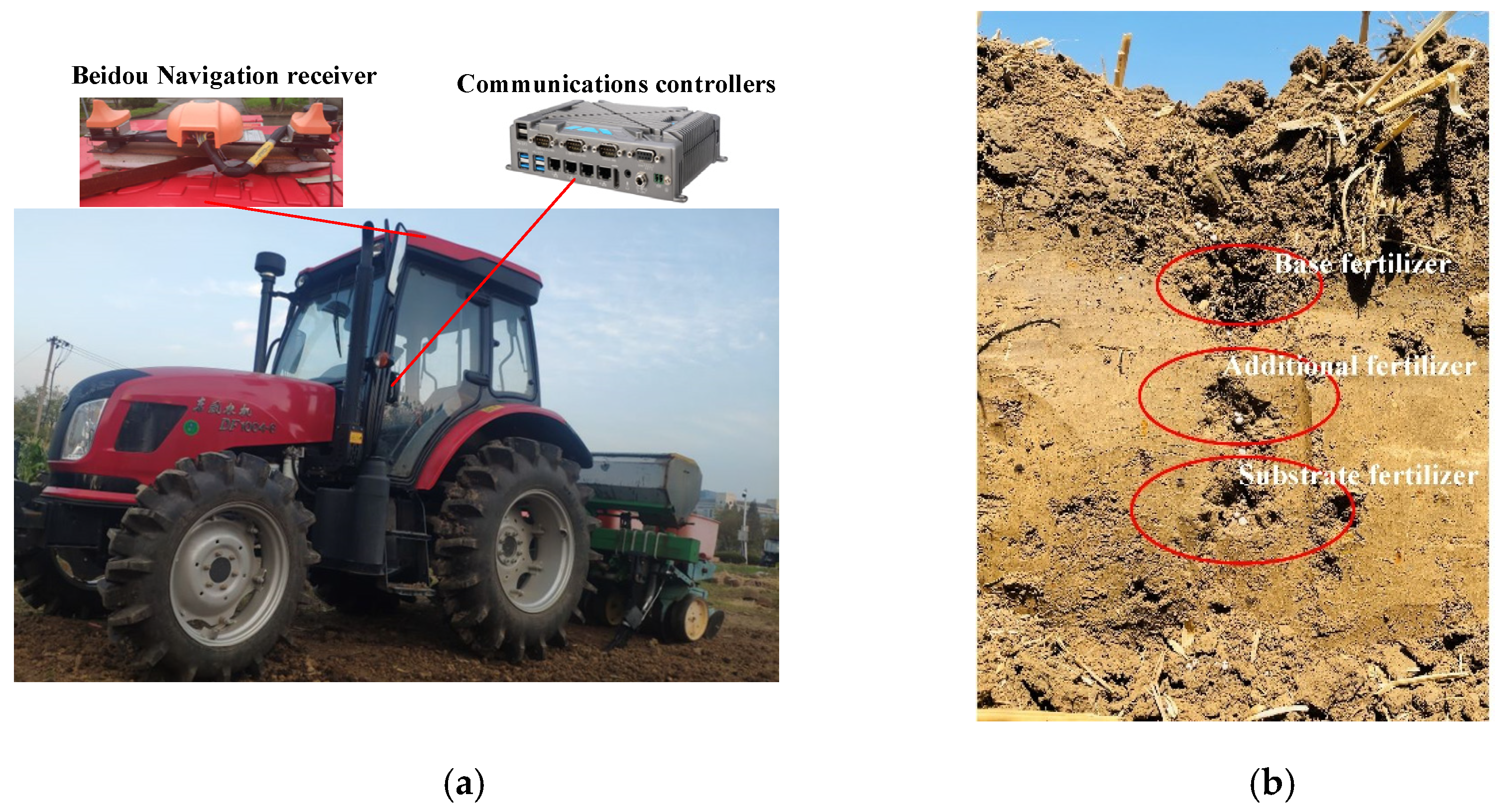
| Paraments | Value | |
|---|---|---|
| Solids density/kg∙m−3 | fertilizer particle | 1575 |
| soil particle | 2500 | |
| steel | 7865 | |
| ABS plastic | 1200 | |
| Shear Modulus/Pa | fertilizer particle | 1.25 × 108 |
| soil particle | 1.00 × 108 | |
| steel | 7.90 × 1010 | |
| ABS plastic | 1.00 × 109 | |
| Poisson’s ratio | fertilizer particle | 0.25 |
| soil particle | 0.30 | |
| steel | 0.37 | |
| ABS plastic | 0.40 | |
| Coefficient of restitution | fertilizer-fertilizer | 0.09 |
| fertilizer-steel | 0.50 | |
| fertilizer-ABS plastic | 0.40 | |
| fertilizer-soil | 0.02 | |
| soil-soil | 0.50 | |
| soil-steel | 0.30 | |
| Coefficient of static friction | fertilizer-fertilizer | 0.30 |
| fertilizer-steel | 0.40 | |
| fertilizer-ABS plastic | 0.20 | |
| fertilizer-soil | 1.25 | |
| soil-soil | 0.50 | |
| soil-steel | 0.50 | |
| Coefficient of rolling friction | fertilizer-fertilizer | 0.25 |
| fertilizer-steel | 0.02 | |
| fertilizer-ABS plastic | 0.09 | |
| fertilizer-soil | 1.25 | |
| soil-soil | 0.15 | |
| soil-steel | 0.05 | |
| Forward Speed/(km/h) | AUF/(°) | AFT/(°) | FDTM/mm | FDTL/mm | FADSCM/% | FADSCL/% |
|---|---|---|---|---|---|---|
| 1 | 50 | 30 | 97.2 | 107.6 | 4.03 | 3.17 |
| 35 | 83.1 | 90.0 | 2.92 | 3.12 | ||
| 40 | 82.2 | 75.1 | 5.66 | 5.82 | ||
| 60 | 30 | 89.7 | 97.3 | 3.19 | 3.12 | |
| 35 | 83.1 | 86.5 | 2.78 | 3.06 | ||
| 40 | 82.1 | 77.0 | 4.48 | 5.81 | ||
| 70 | 30 | 84.3 | 90.3 | 5.03 | 3.80 | |
| 35 | 73.9 | 86.4 | 3.42 | 3.61 | ||
| 40 | 65.1 | 75.6 | 5.93 | 6.55 | ||
| 2 | 50 | 30 | 138.6 | 136.2 | 5.33 | 5.39 |
| 35 | 113.8 | 124.4 | 3.18 | 3.28 | ||
| 40 | 106.2 | 105.9 | 6.70 | 7.28 | ||
| 60 | 30 | 126.6 | 136.4 | 4.79 | 4.80 | |
| 35 | 107.4 | 116.3 | 2.49 | 2.93 | ||
| 40 | 103.2 | 104.3 | 6.48 | 7.15 | ||
| 70 | 30 | 119.7 | 117.2 | 5.79 | 5.45 | |
| 35 | 103.5 | 110.0 | 3.43 | 4.12 | ||
| 40 | 101.0 | 97.6 | 6.60 | 7.04 | ||
| 3 | 50 | 30 | 184.2 | 185.6 | 5.48 | 6.51 |
| 35 | 164.0 | 163.5 | 3.92 | 5.25 | ||
| 40 | 135.2 | 142.1 | 7.41 | 7.82 | ||
| 60 | 30 | 171.6 | 174.2 | 4.90 | 4.37 | |
| 35 | 154.1 | 151.1 | 3.75 | 4.09 | ||
| 40 | 134.2 | 137.4 | 7.11 | 7.45 | ||
| 70 | 30 | 156.8 | 165.9 | 5.12 | 5.76 | |
| 35 | 137.4 | 134.0 | 4.76 | 4.74 | ||
| 40 | 132.7 | 121.1 | 7.82 | 8.03 |
Publisher’s Note: MDPI stays neutral with regard to jurisdictional claims in published maps and institutional affiliations. |
© 2022 by the authors. Licensee MDPI, Basel, Switzerland. This article is an open access article distributed under the terms and conditions of the Creative Commons Attribution (CC BY) license (https://creativecommons.org/licenses/by/4.0/).
Share and Cite
Wang, W.; Song, J.; Zhou, G.; Quan, L.; Zhang, C.; Chen, L. Development and Numerical Simulation of a Precision Strip-Hole Layered Fertilization Subsoiler While Sowing Maize. Agriculture 2022, 12, 938. https://doi.org/10.3390/agriculture12070938
Wang W, Song J, Zhou G, Quan L, Zhang C, Chen L. Development and Numerical Simulation of a Precision Strip-Hole Layered Fertilization Subsoiler While Sowing Maize. Agriculture. 2022; 12(7):938. https://doi.org/10.3390/agriculture12070938
Chicago/Turabian StyleWang, Weiwei, Jiale Song, Guoan Zhou, Longzhe Quan, Chunling Zhang, and Liqing Chen. 2022. "Development and Numerical Simulation of a Precision Strip-Hole Layered Fertilization Subsoiler While Sowing Maize" Agriculture 12, no. 7: 938. https://doi.org/10.3390/agriculture12070938
APA StyleWang, W., Song, J., Zhou, G., Quan, L., Zhang, C., & Chen, L. (2022). Development and Numerical Simulation of a Precision Strip-Hole Layered Fertilization Subsoiler While Sowing Maize. Agriculture, 12(7), 938. https://doi.org/10.3390/agriculture12070938







